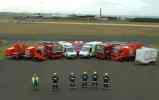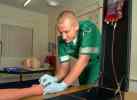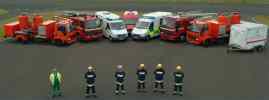| Dounreay Index | |||
|
Dounreay - Fire & Ambulance Service |
|||
|
HISTORY Large numbers of construction workers flocked to the area. Accommodation was very limited and the old naval quarters were used to house the workers. Formed in 1955 with a few volunteers from the Dounreay Transport Section the first fire team composed of drivers would respond to emergency calls on the growing Dounreay site. In the early years most of the fires were of a domestic nature and were located in the contractor’s camp. With much of the site largely constructed the emphasis on fire fighting incidents changed and mainly involved leakage of hot sodium or even more volatile sodium/potassium coolant. It was obvious that a volunteer unit would be unable to cope with the increasing demands being placed upon them and the fire fighters became full time professionals. During the 1960s and 1970s the Brigade gained valuable experience in the knowledge and technology for dealing with liquid metal fires. The 1970s also brought new responsibilities with the addition of nearby HMS Vulcan, a submarine reactor testing establishment, and a new airstrip at Dounreay. In the 1980s, Dounreay Fire Brigade developed and evaluated a new method for fighting sodium fires replacing 145 tons of sodium chloride (salt) with just 12 tons of the new extremely efficient graphex powder. A range of extinguishers were designed to discharge this powder. New protective suits for use in liquid metal fires were pioneered by the Dounreay Fire Brigade.
TODAY’S BRIGADE Due to the remote location and limited assistance available it is important that the unit is well equipped and highly trained. Recruits attend the 12-week recruits’ course at the Scottish Fire Services College, Gullane. Further training for Officers and Fire Fighters is obtained at Morton-in-Marsh, Gullane and other fire service training establishments. Fire Fighters perform a dual role and are trained as Ambulance Technicians by the Scottish Ambulance Service. This requires them to attend a 9-week course at the Scottish Ambulance Service training school at North Berwick. They also receive further training on specialist techniques for dealing with contaminated patients. The Brigade participate in several major exercises each year to meet the requirements of the Nuclear Installations Inspectorate (NII), Ministry of Defence (MoD) and test the emergency plans for the Scottish Ambulance Service and the Highland and Islands Fire Brigade.
Two graphex tenders, the only 2 of their type in the world, each carry 1000 kg of graphex powder. This powder is used to extinguish metal fires. Each year the Brigade attends approximately 15 to 20 fires. These are mostly of a minor nature. They attend 80 to 90 ambulance calls, which can range from a cut finger to a heart attack. The response to approximately 50 special services per year is also an important part of their role. These range from rescue situations through to pumping operations. Annually the Fire Brigade carry out over 250 fire safety inspections on site buildings to ensure they meet the requirements of the site fire certificate which is issued under the Special Premises Regulations 1976. The Brigade is also consulted on all fire safety aspects relating to projects, construction or alteration of buildings. The Brigade carries out all fire safety risk assessments to ensure compliance with the Fire Precautions Workplace Regulations.
Care and maintenance is an important part of the Brigade’s function. Annually inspections and tests are carried out on over 500 pieces of equipment as part of a computerised maintenance and inspection test schedule. This included 3700 tests and inspections on fire extinguishers and fixed installations. A total of 20,000 tests and inspections are performed by the Brigade each year. Annually the Brigade trains 2500 people in first aid, breathing apparatus, fire safety, confined space and forward control point liaison officer courses. Other services provided by the Brigade include advice, support and provision of equipment to ensure the site complies with Confined Space and Dangerous Substances and Explosive Atmosphere Regulations. All work undertaken is carefully monitored by the production of monthly performance parameters ensuring quality and targets are achieved. The Brigade looks forward to further challenges as the Dounreay site undergoes its 50-60 year decommissioning programme. It is anticipated that this will bring additional work for the Brigade as large-scale construction, decommissioning and demolition work increases. Their aim is to provide a quality service and add to their experience, which has led them to be regarded as acknowledged experts in their field. |
|||




